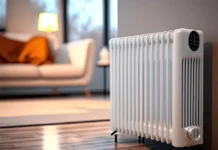C batteries (or R14 batteries) are standard-sized dry cells used in all types of devices. Since they are dry cells, the inside contains very minimal moisture. That’s why they are a staple for a variety of portable devices in the home. The International Electrochemical Commission (IEC) christened them as R14. C batteries exist in various types, which we explain in greater detail below.
Non-Rechargeable C Batteries
Non-rechargeable batteries are single-use cells that are discarded once they get depleted. Thus, you cannot recharge and use these batteries again. When it comes to C batteries, they are mainly considered alkaline batteries. They are composed of chemicals such as manganese dioxide and zinc. The alkaline in the cell is the manganese dioxide, hence the name. When the zinc gets depleted, the battery will entirely run out of power.
Alkaline C batteries are high when it comes to powering portable devices like remote controls, toys, and so on. The cells have a long shelf-life, cycle life, and low leakage. Because of that, they can protect your electronics from possible damage by water. The following are examples of applications to which the batteries can be put.
- Clocks
- Radios
- Remote controls
- Torches
- Toys
Rechargeable C Batteries
Rechargeable C batteries have the capacity of being recharged and reused. When it comes to the initial cost, these batteries tend to cost more. Safe recharging and proper use ensure that the batteries last for a long time. C batteries under this category may fall into any of the following groups.
1. Lithium-Ion (Li-Ion) C Batteries
Made from lithium metal, Li-ion batteries are the latest as far as rechargeable technology is concerned. They provide a cost-effective way of powering most portable devices. Some may even come already built into the devices they power. They are the best rechargeable C batteries on the market. Mostly they come with 3.7V as the nominal voltage, even though there are others with 3.6V and 7.2V ratings. Li-ion batteries are light and come with a high C-rating. The cell voltage for these batteries is exceptionally high, just as is the power density. So of the applications to which you can put the batteries include the following:
- Automatic meter readers and utility meters
- Buoys
- Industrial applications
- Measuring equipment
- Professional electronics
2. Lithium Manganese Dioxide (Li-MnO2) C Batteries
These batteries are mainly made of a combination of lithium and manganese dioxide. They are rechargeable batteries that rely on non-toxic, less-expensive, abundantly available materials. The batteries come with a 3.0V rating at a relatively low cost. They come with a superior shelf-life, high voltage capacity, and longer runtime. Li-MnO2 batteries are safer than other rechargeable batteries and can operate in temperatures ranging from -20°C and 60°C. Since they are more reliable, you don’t need to install any safety equipment. The batteries have many applications, including the following.
- Gas leak detectors
- Mining applications
- Petrochemical facilities
- Smart gas meters
- Oil tank level monitoring
- Emergency location transmitters beacons
- Military radio communications
- Cardiac defibrillators
3. Nickel – Metal Hydride (Ni-MH) C Batteries
Even though an older technology, Ni-MH C batteries have the advantage of being recharged over and over again. The voltage rating is a little lower than that of Li-ion and alkaline batteries. However, since they are easy to find and have a lower environmental impact, the cells can still serve your needs. They are easy to recharge, have a high power density, and a suitable replacement for alkaline batteries. The main applications to which you can put these batteries include the following:
- Clocks
- Radios
- Remote controls
- Torches
- Toys
4. Nickel and Cadmium Chemical Composition (Ni-Cd) Batteries
The primary materials used to make these batteries include nickel and cadmium. They have the lowest discharge rate among all the rechargeable batteries we have discussed so far. That’s why you will find their prices very affordable. The Ni-Cd C batteries come with a 1.2V nominal voltage. You have to connect together three of them to get the energy of one Li-ion battery. These batteries are easy to recharge and can work in whatever environment. However, the power density is much less, and they contain metals that could emit toxins. Without frequent recharging, the battery plate may develop unwanted crystals. These batteries can be used in any of the following ways.
- Cameras
- Intruder alarms
- Musical instruments
- Radios
- Toys
- Torches
- Walkie-talkies
The Bottom Line
When it comes to operating some of your portable electronics, you cannot do without a good quality c battery. Since the different types have varied voltage ratings, they tend to last for diverse lengths of time. Even so, the type of cell you can use in a given device will depend on the voltage requirement. If you are into recycling, then make sure you buy more of the rechargeable batteries. Otherwise, you are better off buying the ones that do not need to be recharged.




















